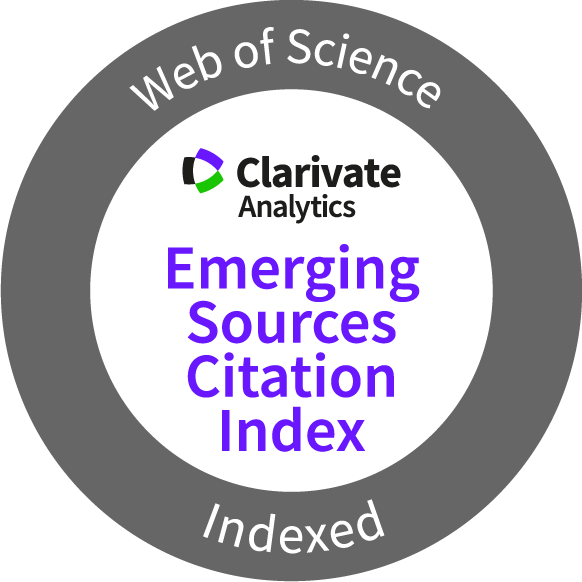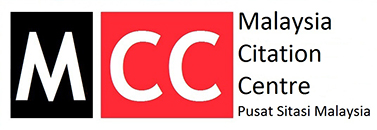Evaluation of Bacillus-Associated Polyethylene Terephthalate (PET) Surfaces For Biodegradation
Keywords:
Bacillus, biodegradation, microplastic, PET, synthethic polymersAbstract
The escalating threat of polyethylene terephthalate (PET) microplastic pollution necessitates an urgent environmentally friendly approach. This study explores the potential of local bacterial isolates to biodegrade PET microplastics. Bacteria isolated from the surface of PET plastic bottles taken from Dengkil Inert Waste Landfill were screened for esterase activity and biofilm formation. PET degradation was assessed through mass weight reduction, scanning electron microscope (SEM) analysis for morphological changes, and Fourier-transform infrared spectroscopy (FT-IR) for chemical structure alterations. Two of the five selected isolates were positive for producing esterase and biofilm ability as well as biodegrade PET leading to a 2.04% - 2.08% degradation (20 days incubation). FT-IR indicated changes in PET chemical structure, particularly in C-H, C=O, and C-O bonds, while SEM revealed morphological changes such as cracks and holes on the PET surface. Identification through 16S rRNA sequencing indicated bacterial isolates are Bacillus paramycoides DIWL 1, Bacillus cereus DIWL 2, Bacillus safensis DIWL 3, Bacillus luciferensis DIWL 4, and Bacillus cereus DIWL 5. The results of this study can be used for further research on the potential of local isolates in the decomposition of PET microplastics which in turn can be used to develop a sustainable and cost-effective microplastic treatment (PET) technology.
Downloads
Metrics
References
Amelia, T.S.M., Khalik, W.M.A.W.M., Ong, M.C., Shao, Y.T., Pan, H.J. & Bhubalan, K. 2021. Marine microplastics as vectors of major ocean pollutants and its hazards to the marine ecosystem and humans. Progress in Earth and Planetary Science, 8: 12. DOI: https://doi.org/10.1186/s40645-020-00405-4
Auta, H.S., Emenike, C.U. & Fauziah, S.H. 2017. Screening of Bacillus strains isolated from mangrove ecosystems in Peninsular Malaysia for microplastic degradation. Environmental Pollution, 231: 1552–1559. DOI: https://doi.org/10.1016/j.envpol.2017.09.043
Belabbas, H., Djinni, I., Djoudi, W., Reti, W., Hamma, A., Souagui, S., Haddad, S. & Kecha, M. 2025. Streptomyces coeruleorubidus strain SALG1 derived seashore plastic bottle for the biodegradation of untreated plastic polymers. Environmental Science and Pollution Research, 1-18. DOI: https://doi.org/10.1007/s11356-025-36027-w
Chamas, A., Moon, H., Zheng, J., Qiu, Y., Tabassum, T., Jang, J. H., Abu-Omar, M., Scott, S.L. & Suh, S. 2020. Degradation rates of plastics in the environment. ACS Sustainable Chemistry & Engineering, 8(9): 3494-3511. DOI: https://doi.org/10.1021/acssuschemeng.9b06635
Charnock, C. 2021. Norwegian soils and waters contain mesophilic, plastic-degrading bacteria. Microorganisms, 9(1): 1–18. DOI: https://doi.org/10.3390/microorganisms9010094
Chauhan, D., Agrawal, G., Deshmukh, S., Roy, S.S. & Priyadarshini, R. 2018. Biofilm formation by Exiguobacterium sp. DR11 and DR14 alter polystyrene surface properties and initiate biodegradation. RSC Advances, 8: 37590–37599. DOI: https://doi.org/10.1039/C8RA06448B
Chen, H.L., Nath, T.K., Chong, S., Foo, V., Gibbins, C. & Lechner, A.M. 2021. The plastic waste problem in Malaysia: management, recycling and disposal of local and global plastic waste. SN Applied Sciences 3(4): 1–15. DOI: https://doi.org/10.1007/s42452-021-04234-y
Dąbrowska, G.B., Janczak, K. & Richert, A. 2021. Combined use of Bacillus strains and Miscanthus for accelerating biodegradation of poly(lactic acid) and poly(ethylene terephthalate). PeerJ, 9: 1–21. DOI: https://doi.org/10.7717/peerj.10957
Demirkan, E., Guler, B.E. & Sevgi, T. 2020. Analysis by scanning electron microscopy of polyethylene terephthalate and nylon biodegradation abilities of Bacillus sp. strains isolated from soil. Journal of Biological & Environmental Sciences, 14(42): 107–114.
Farzi, A., Dehnad, A. & Fotouhi, A.F. 2019. Biodegradation of polyethylene terephthalate waste using Streptomyces species and kinetic modelling of the process. Biocatalysis and Agricultural Biotechnology, 17: 25–31. DOI: https://doi.org/10.1016/j.bcab.2018.11.002
Habib, S., Iruthayam, A., Shukor, M.Y.A., Alias, S.A., Smykla, J. & Yasid, N.A. 2020. Biodeterioration of untreated polypropylene microplastic particles by Antarctic bacteria. Polymers, 12(11): 1–12. DOI: https://doi.org/10.3390/polym12112616
Issac, M.N. & Kandasubramanian, B. 2021. Effect of microplastics in water and aquatic systems. Environmental Science and Pollution Research 28(16): 19544-19562. DOI: https://doi.org/10.1007/s11356-021-13184-2
Kirmusaoğlu, S. 2019. The methods for detection of biofilm and screening antibiofilm activity of agents. In: Antimicrobials, Antibiotic Resistance, Antibiofilm Strategies and Activity Methods. S. Kirmusaoğlu (Ed.). IntechOpen, Rijeka. pp. 1-17. DOI: https://doi.org/10.5772/intechopen.84411
Kumari, A., Bano, N., Bag, S.K., Chaudhary, D.R. & Jha, B. 2021. Transcriptome-guided insights into plastic degradation by the marine bacterium. Frontiers in Microbiology, 12: 1–13. DOI: https://doi.org/10.3389/fmicb.2021.751571
Maity, S., Banerjee, S., Biswas, C., Guchhait, R., Chatterjee, A. & Pramanick, K. 2021. Functional interplay between plastic polymers and microbes: a comprehensive review. Biodegradation, 32(5): 487–510. DOI: https://doi.org/10.1007/s10532-021-09954-x
Mallakpour, S. & Nouruzi, N. 2018. Polycaprolactone/metal oxide nanocomposites: An overview of recent progress and applications. In: Biodegradable and Biocompatible Polymer Composites: Processing, Properties and Applications. N. G. Shimpi (Ed.). Woodhead Publishing, Cambridge. pp. 223–263. DOI: https://doi.org/10.1016/B978-0-08-100970-3.00008-0
Mohanan, N., Montazer, Z., Sharma, P.K. & Levin, D.B. 2020. Microbial and enzymatic degradation of synthetic plastics. Frontiers in Microbiology, 11: 1–22. DOI: https://doi.org/10.3389/fmicb.2020.580709
Molitor, R., Bollinger, A., Kubicki, S., Loeschcke, A., Jaeger, K.E. & Thies, S. 2019. Agar plate-based screening methods for the identification of polyester hydrolysis by Pseudomonas species. Microbial Biotechnology, 13(1): 274–284. DOI: https://doi.org/10.1111/1751-7915.13418
Nakkabi, A., Elmoualij, N., Saad, I.K. & Fahim, M.F. 2015. Biodegradation of poly(ethylene terephthalate) by Bacillus subtilis. International Journal of Recent Advances in Multidisciplinary Research, 2(12): 1060–1062.
Noik, V.J. and Tuah, P.M. 2015. A first survey on the abundance of plastics fragments and particles on two sandy beaches in Kuching, Sarawak, Malaysia. In: IOP Conference Series: Materials Science and Engineering. IOP Publishing, United Kingdom, 78: 012035. DOI: https://doi.org/10.1088/1757-899X/78/1/012035
Nowak, B., Pająk, J., Drozd-Bratkowicz, M. & Rymarz, G. 2011. Microorganisms participating in the biodegradation of modified polyethylene films in different soils under laboratory conditions. International Biodeterioration & Biodegradation, 65(6): 757-767. DOI: https://doi.org/10.1016/j.ibiod.2011.04.007
Puglisi, E., Romaniello, F., Galletti, S., Boccaleri, E., Frache, A. & Cocconcelli, P.S. 2019. Selective bacterial colonization processes on polyethylene waste samples in an abandoned landfill site. Scientific Reports, 9(1): 1–13. DOI: https://doi.org/10.1038/s41598-019-50740-w
Pui, C.F., Wong, W.C., Chai, L.C., Lee, H.Y., Noorlis, A., Zainazor, T.C.T., Tang, J.Y.H., Ghazali, F.M., Cheah, Y.K., Nakaguchi, Y., Nishibuchi, M. & Radu, S. 2011. Multiplex PCR for the concurrent detection and differentiation of Salmonella spp., Salmonella typhi and Salmonella typhimurium. Tropical Medicine and Health, 39(1): 9–15. DOI: https://doi.org/10.2149/tmh.2010-20
Qi, X., Yan, W., Cao, Z., Ding, M. & Yuan, Y. 2022. Current advances in the biodegradation and bioconversion of polyethylene terephthalate. Microorganisms, 10(1): 1–25. DOI: https://doi.org/10.3390/microorganisms10010039
Raddadi, N. & Fava, F. 2019. Biodegradation of oil-based plastics in the environment: Existing knowledge and needs of research and innovation. Science of the Total Environment, 679: 148-158. DOI: https://doi.org/10.1016/j.scitotenv.2019.04.419
Roberts, C., Edwards, S., Vague, M., León-Zayas, R., Scheffer, H., Chan, G., Swartz, N.A. & Mellies, J.L. 2020. Environmental consortium containing Pseudomonas and Bacillus species synergistically degrades polyethylene terephthalate plastic. Applied and Environmental Science, 5(6). DOI: https://doi.org/10.1128/mSphere.01151-20
Ruslan, R., Pekey, A.Y., Iqbal, M., Dewi, A.P. & Djamaan, A. 2018. Characterization of Bacillus sp. Itp 10.2.1 as degrading-bacteria of polyethylene terephthalate (PET) synthetic plastic. International Research Journal of Pharmacy, 9(11): 56–59. DOI: https://doi.org/10.7897/2230-8407.0911258
Sharon, M. & Sharon, C. 2012. Studies on biodegradation of polyethylene terephthalate: a synthetic polymer. Scholars Research Library, 2(2): 248–257.
Srivastava, P., Saji, J. & Manickam, N. 2024. Biodegradation of polyethylene terephthalate (PET) by Brucella intermedia IITR130 and its proposed metabolic pathway. Biodegradation. DOI: https://doi.org/10.1007/s10532-024-10070-9
Taniguchi, I., Yoshida, S., Hiraga, K., Miyamoto, K., Kimura, Y. & Oda, K. 2019. Biodegradation of PET: Current status and application aspects. ACS Catalysis, 9: 4089–4105. DOI: https://doi.org/10.1021/acscatal.8b05171
Torena, P., Alvarez-Cuenca, M. & Reza, M. 2021. Biodegradation of polyethylene terephthalate microplastics by bacterial communities from activated sludge. Canadian Journal of Chemical Engineering, 1–14. DOI: https://doi.org/10.1002/cjce.24015
Vague, M., Chan, G., Roberts, C., Swartz, N.A. & Mellies, J.L. 2019. Pseudomonas isolates degrade and form biofilms on polyethylene terephthalate (PET) plastic. Sustainability, 11(1): 1–14. DOI: https://doi.org/10.1101/647321
Wang, P., Dai, H., Sun, B., Che, C. & Zhu, R. 2022. Bacteria community vertical distribution and its response characteristics to waste degradation degree in a closed landfill. Applied Sciences, 12(6): 2965. DOI: https://doi.org/10.3390/app12062965
Webb, H. 2012. Biodegradation of poly(ethylene terephthalate) by marine bacteria, and strategies for its enhancement (PhD). Swinburne University of Technology.
Webb, H.K., Arnott, J., Crawford, R.J. & Ivanova, E.P. 2013. Plastic degradation and its environmental implications with special reference to poly(ethylene terephthalate). Polymers, 5: 1–18. DOI: https://doi.org/10.3390/polym5010001
Xuyang, W., Khalil, K., Zhuo, T., Keyan, C., Nazir, M.Y.M., Aqma, W.S. & Hong, N.Q. 2025. Addressing the plastisphere: Sustainable approaches to combat plastic pollution. Science of the Total Environment, 959: 178105. DOI: https://doi.org/10.1016/j.scitotenv.2024.178105
Yang, J., Yang, Y., Wu, W., Zhao, J. & Jiang, L. 2014. Evidence of polyethylene biodegradation by bacterial strains from the guts of plastic-eating waxworms. Environmental Science and Technology, 48: 13776−13784. DOI: https://doi.org/10.1021/es504038a
Yuan, J., Ma, J., Sun, Y., Zhou, T., Zhao, Y. & Yu, F. 2020. Microbial degradation and other environmental aspects of microplastics/plastics. Science of the Total Environment, 715: 136968. DOI: https://doi.org/10.1016/j.scitotenv.2020.136968
Published
How to Cite
Issue
Section
Any reproduction of figures, tables and illustrations must obtain written permission from the Chief Editor (wicki@ukm.edu.my). No part of the journal may be reproduced without the editor’s permission
Funding data
-
Ministry of Higher Education, Malaysia
Grant numbers FRGS/1/2020/STG01/UKM/02/7.




















